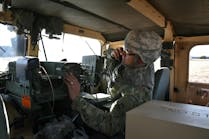EDITOR’S NOTEBOOK: DARPA details requirements for high-energy diode-laser initiative
By John Keller
ARLINGTON, Va.-Scientists at the U.S. Defense Advanced Research Projects Agency (DARPA) in Arlington, Va., are moving ahead with a program to develop a 100-kilowatt weapons-grade diode laser capable of destroying military targets.
The program, called Architecture for Diode High Energy Laser Systems (ADHELS), seeks to generate bright high-power laser beams for the military by combining the beams of laser diodes, arrays, or stacks, leading ultimately to 100-kilowatt lasers with near-diffraction-limited beam propagation at wavelengths that travel efficiently through the atmosphere.
Officials of the DARPA Microsystems Technology Office want to use this kind of laser capability to project a beam “to a distant target with a suitable beam director to meet mission objectives,” according to the ADHELS project federal solicitation (BAA05-09).
DARPA officials say they will choose contractors for the ADHELS program in the second half of this year.
ADHELS phase 1
The 18-month first phase of the ADHELS program is to develop bright, high-power laser diodes and beam-combining and mode-control devices that are strong enough to scale their designs up to 100 kilowatts.
The total optical power of the individual diodes in phase 1 must be 500 watts, and the center wavelength of the combined beam can be either 865 or 1040 nanometers. Diode lifetimes-or the time for the diode power level to fall below 80 percent of the initial diode power level in continuous operation-must be at least 200 hours.
DARPA optoelectronics experts say they strongly prefer passive beam combining and mode control over active beam combining. Passive methods can include spatial filters, grating couplers, phase conjugators, liquid crystals, wavelength couplers, and other transform systems.
The combined beam format should be approximately circular; hexagons and squares are acceptable, but a 1-by-2 rectangle is not. DARPA is requiring diodes yielding a combined diode-array bandwidth of 50 nanometers centered at 865 or 1040 nanometers. The exit aperture diameter for a 100-kilowatt laser should be no larger than 12 centimeters.
ADHELS phase 2
The 18-month second phase of the ADHELS program is to improve laser-diode and beam-combining technologies enough to build a 10-kilowatt demonstration laser that ultimately is scalable up to at least 100 kilowatts.
The company or companies involved in the program must demonstrate diode lifetimes of at least 1000 hours. When finished, an independent government-designated team will measure and evaluate the demonstration lasers during 10-minute tests.
DARPA experts are emphasizing low-risk design approaches in scaling demonstration laser systems from 10 to 100 kilowatts. DARPA officials say they will consider approaches other than an all-diode laser system if the approach is scalable and satisfies other specifications of an all-diode system.
Those competing for the ADHELS program must be up front about the main risk items in scaling their technology from one phase to the next, especially power density and power per unit bandwidth.
For example, if companies propose spectral beam combining as the approach to use in scaling to 100 kilowatts within 50 nanometers, the phase-2 goal should be to produce a 10-kilowatt beam with a spectral bandwidth of 5 nanometers.
Those interested must submit proposals by April 26.
To voice technical questions or concerns about the ADHELS program, contact DARPA’s C. Martin Stickley by phone at 703-696-2206, by e-mail at [email protected] or [email protected], or by fax at 703-696-2206.
For non-technical administrative questions or concerns, contact the DARPA ADHELS office by e-mail at BAA05‑[email protected], by fax at 703-696-2206 (refer to DARPA/MTO, BAA 05-09), or by post at DARPA/MTO, Attn: BAA 05-09, 3701 North Fairfax Drive, Arlington, Va., 22203-1714.
For more information see the ADHELS solicitation online at www.eps.gov/spg/ODA/DARPA/CMO/BAA05%2D09/SynopsisP.html.


